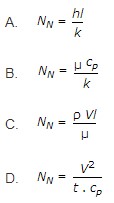41. During a refrigeration cycle, heat is rejected by the refrigerant in a
A. compressor
B. condenser
C. evaporator
D. expansion valve
42. A refrigeration system
A. removes heat from a low temperature body and delivers it to a high temperature body
B. removes heat from a high temperature body and delivers it to a low temperature body
C. rejects energy to a low temperature body
D. none of the above
43. The subcooling in a refrigeration cycle
A. does not alter C.O.P.
B. increases C.O.P.
C. decreases C.O.P.
D. none of these
44. Nusselt number (NN) is given by

45. During sensible cooling of air __________ decreases.
A. wet bulb temperature
B. relative humidity
C. dry bulb temperature
D. specific humidity
46. The critical radius is the insulation radius at which the resistance to heat flow is
A. maximum
B. minimum
C. zero
D. none of these
47. In case of solids, the heat transfer takes place according to radiation.
A. Correct
B. Incorrect
48. A water cooled condenser operates at a __________ condensing temperature than an air-cooled condenser.
A. higher
B. lower
49. The relative humidity decreases as air gets wet.
A. True
B. False
50. The temperature of ammonia after compression in a vapor compression system is
A. 20 to 50° C
B. 50 to 70° C
C. 70 to 110° C
D. none of these